Brand Management Report: Nestle's Portfolio and Value Techniques
VerifiedAdded on 2021/02/20
|15
|5084
|153
Report
AI Summary
This report provides a detailed analysis of Nestle's brand management strategies. It begins with an introduction to brand management and its importance, followed by an examination of Nestle's brand equity, including Aaker's model and customer-based brand equity using Keller's model. The report explores brand extension strategies, such as those outlined in Ansoff's Matrix, and discusses techniques for reinforcing and revitalizing brands. Furthermore, it delves into Nestle's brand portfolio strategy, including the house of brands model. The report concludes by outlining various techniques for measuring and managing brand value, brand awareness, market share, consumer attitude, and purchasing intent. The report highlights Nestle's success and provides insights into its approach to brand management.
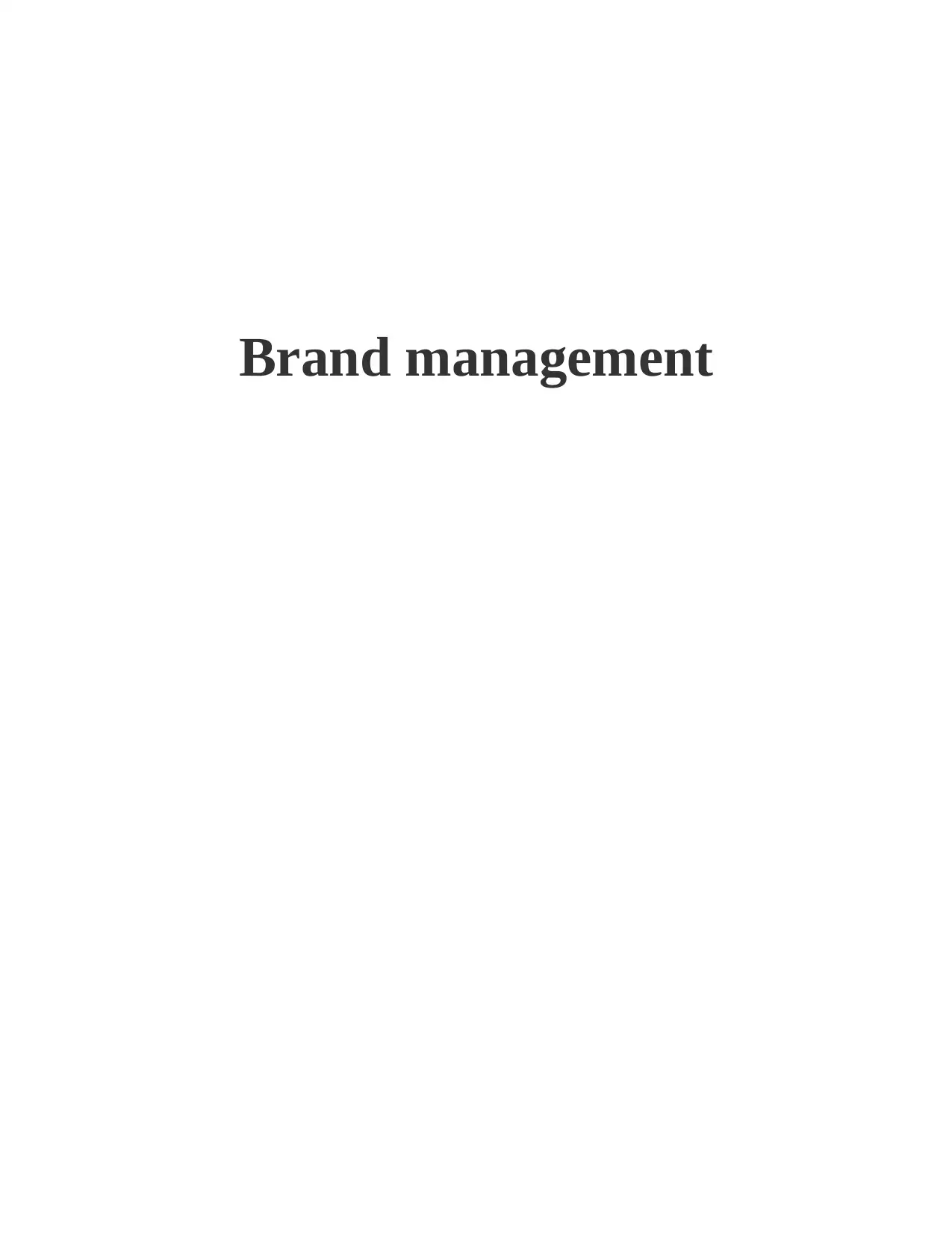
Brand management
Paraphrase This Document
Need a fresh take? Get an instant paraphrase of this document with our AI Paraphraser
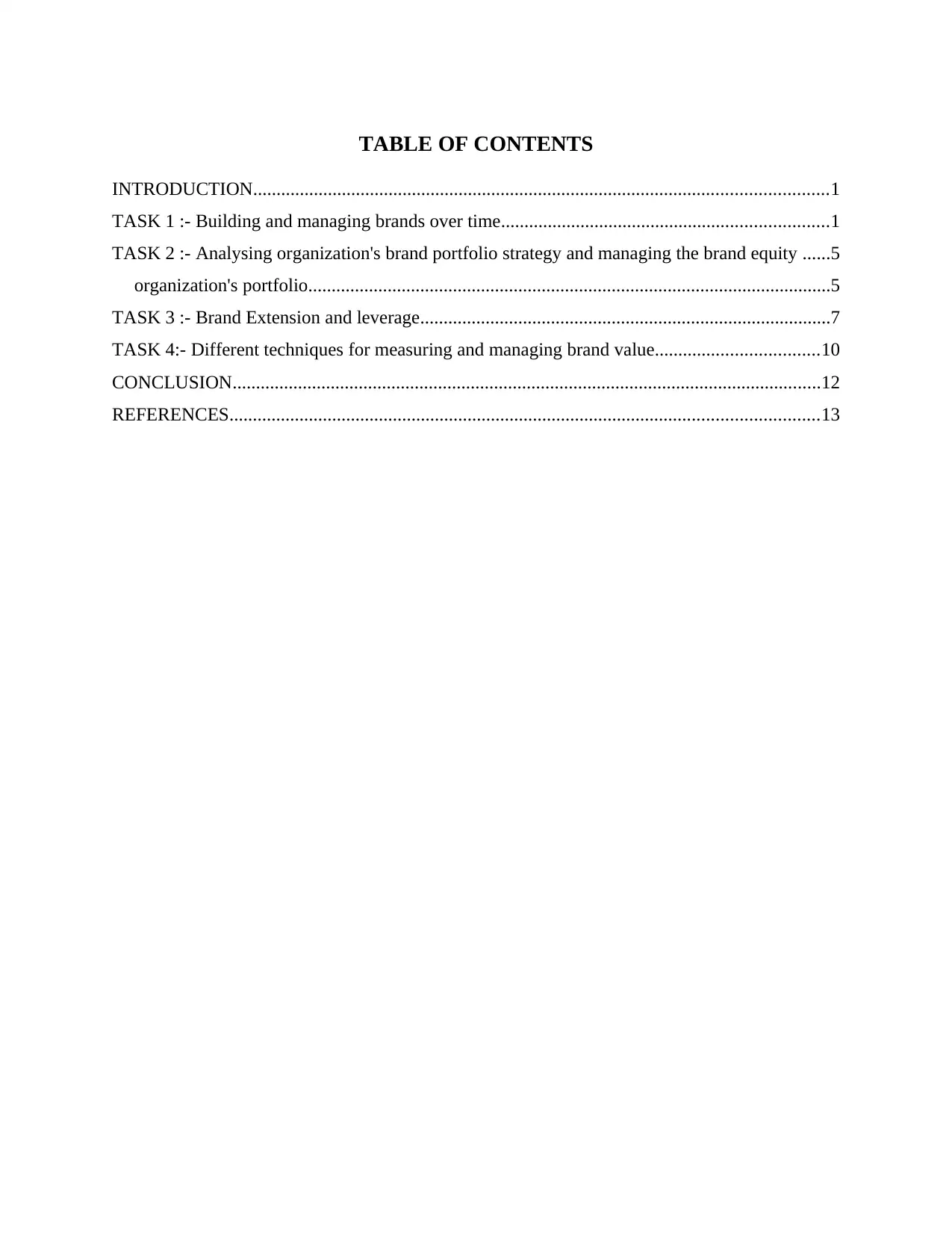
TABLE OF CONTENTS
INTRODUCTION...........................................................................................................................1
TASK 1 :- Building and managing brands over time......................................................................1
TASK 2 :- Analysing organization's brand portfolio strategy and managing the brand equity ......5
organization's portfolio................................................................................................................5
TASK 3 :- Brand Extension and leverage........................................................................................7
TASK 4:- Different techniques for measuring and managing brand value...................................10
CONCLUSION..............................................................................................................................12
REFERENCES..............................................................................................................................13
INTRODUCTION...........................................................................................................................1
TASK 1 :- Building and managing brands over time......................................................................1
TASK 2 :- Analysing organization's brand portfolio strategy and managing the brand equity ......5
organization's portfolio................................................................................................................5
TASK 3 :- Brand Extension and leverage........................................................................................7
TASK 4:- Different techniques for measuring and managing brand value...................................10
CONCLUSION..............................................................................................................................12
REFERENCES..............................................................................................................................13
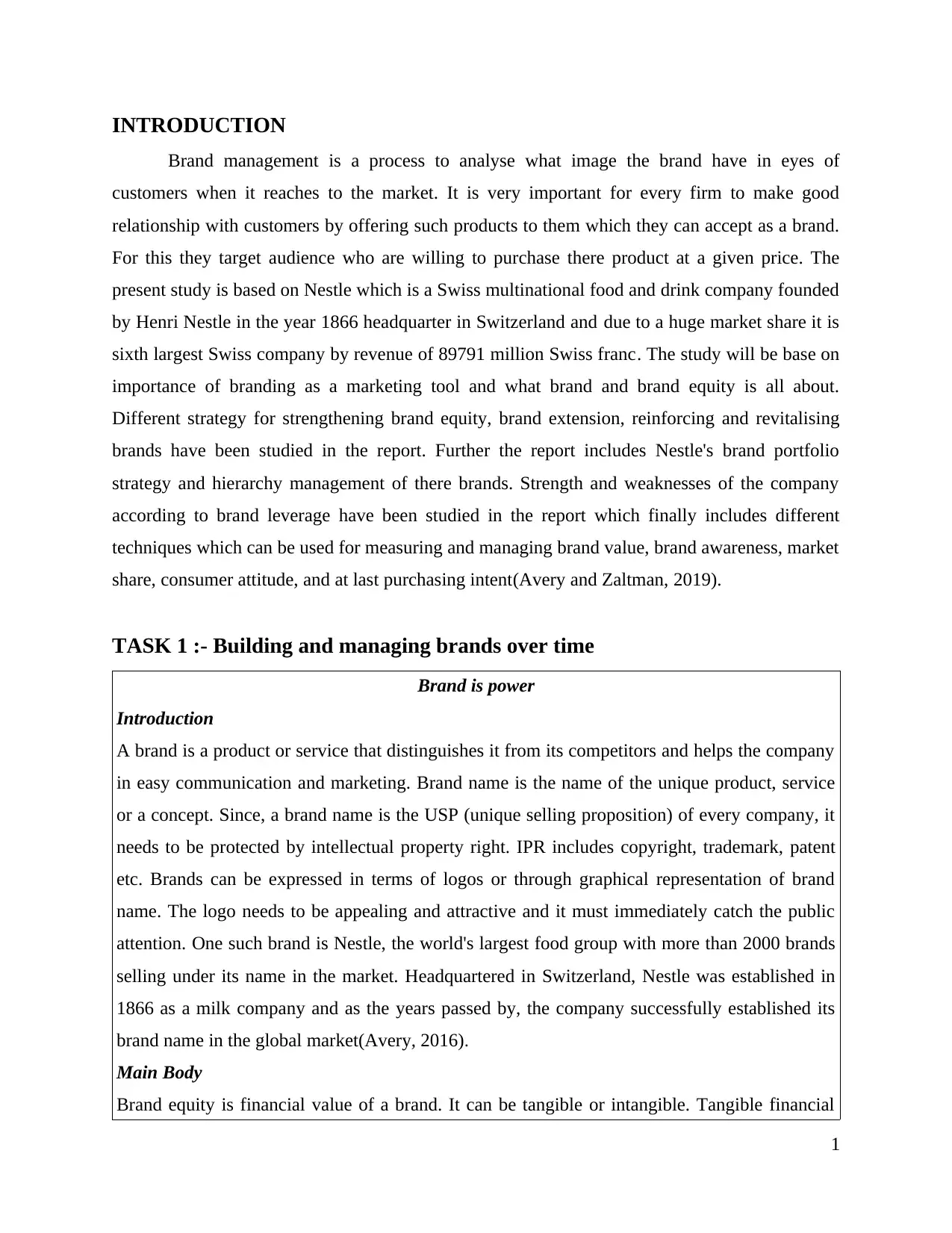
INTRODUCTION
Brand management is a process to analyse what image the brand have in eyes of
customers when it reaches to the market. It is very important for every firm to make good
relationship with customers by offering such products to them which they can accept as a brand.
For this they target audience who are willing to purchase there product at a given price. The
present study is based on Nestle which is a Swiss multinational food and drink company founded
by Henri Nestle in the year 1866 headquarter in Switzerland and due to a huge market share it is
sixth largest Swiss company by revenue of 89791 million Swiss franc. The study will be base on
importance of branding as a marketing tool and what brand and brand equity is all about.
Different strategy for strengthening brand equity, brand extension, reinforcing and revitalising
brands have been studied in the report. Further the report includes Nestle's brand portfolio
strategy and hierarchy management of there brands. Strength and weaknesses of the company
according to brand leverage have been studied in the report which finally includes different
techniques which can be used for measuring and managing brand value, brand awareness, market
share, consumer attitude, and at last purchasing intent(Avery and Zaltman, 2019).
TASK 1 :- Building and managing brands over time
Brand is power
Introduction
A brand is a product or service that distinguishes it from its competitors and helps the company
in easy communication and marketing. Brand name is the name of the unique product, service
or a concept. Since, a brand name is the USP (unique selling proposition) of every company, it
needs to be protected by intellectual property right. IPR includes copyright, trademark, patent
etc. Brands can be expressed in terms of logos or through graphical representation of brand
name. The logo needs to be appealing and attractive and it must immediately catch the public
attention. One such brand is Nestle, the world's largest food group with more than 2000 brands
selling under its name in the market. Headquartered in Switzerland, Nestle was established in
1866 as a milk company and as the years passed by, the company successfully established its
brand name in the global market(Avery, 2016).
Main Body
Brand equity is financial value of a brand. It can be tangible or intangible. Tangible financial
1
Brand management is a process to analyse what image the brand have in eyes of
customers when it reaches to the market. It is very important for every firm to make good
relationship with customers by offering such products to them which they can accept as a brand.
For this they target audience who are willing to purchase there product at a given price. The
present study is based on Nestle which is a Swiss multinational food and drink company founded
by Henri Nestle in the year 1866 headquarter in Switzerland and due to a huge market share it is
sixth largest Swiss company by revenue of 89791 million Swiss franc. The study will be base on
importance of branding as a marketing tool and what brand and brand equity is all about.
Different strategy for strengthening brand equity, brand extension, reinforcing and revitalising
brands have been studied in the report. Further the report includes Nestle's brand portfolio
strategy and hierarchy management of there brands. Strength and weaknesses of the company
according to brand leverage have been studied in the report which finally includes different
techniques which can be used for measuring and managing brand value, brand awareness, market
share, consumer attitude, and at last purchasing intent(Avery and Zaltman, 2019).
TASK 1 :- Building and managing brands over time
Brand is power
Introduction
A brand is a product or service that distinguishes it from its competitors and helps the company
in easy communication and marketing. Brand name is the name of the unique product, service
or a concept. Since, a brand name is the USP (unique selling proposition) of every company, it
needs to be protected by intellectual property right. IPR includes copyright, trademark, patent
etc. Brands can be expressed in terms of logos or through graphical representation of brand
name. The logo needs to be appealing and attractive and it must immediately catch the public
attention. One such brand is Nestle, the world's largest food group with more than 2000 brands
selling under its name in the market. Headquartered in Switzerland, Nestle was established in
1866 as a milk company and as the years passed by, the company successfully established its
brand name in the global market(Avery, 2016).
Main Body
Brand equity is financial value of a brand. It can be tangible or intangible. Tangible financial
1
⊘ This is a preview!⊘
Do you want full access?
Subscribe today to unlock all pages.

Trusted by 1+ million students worldwide
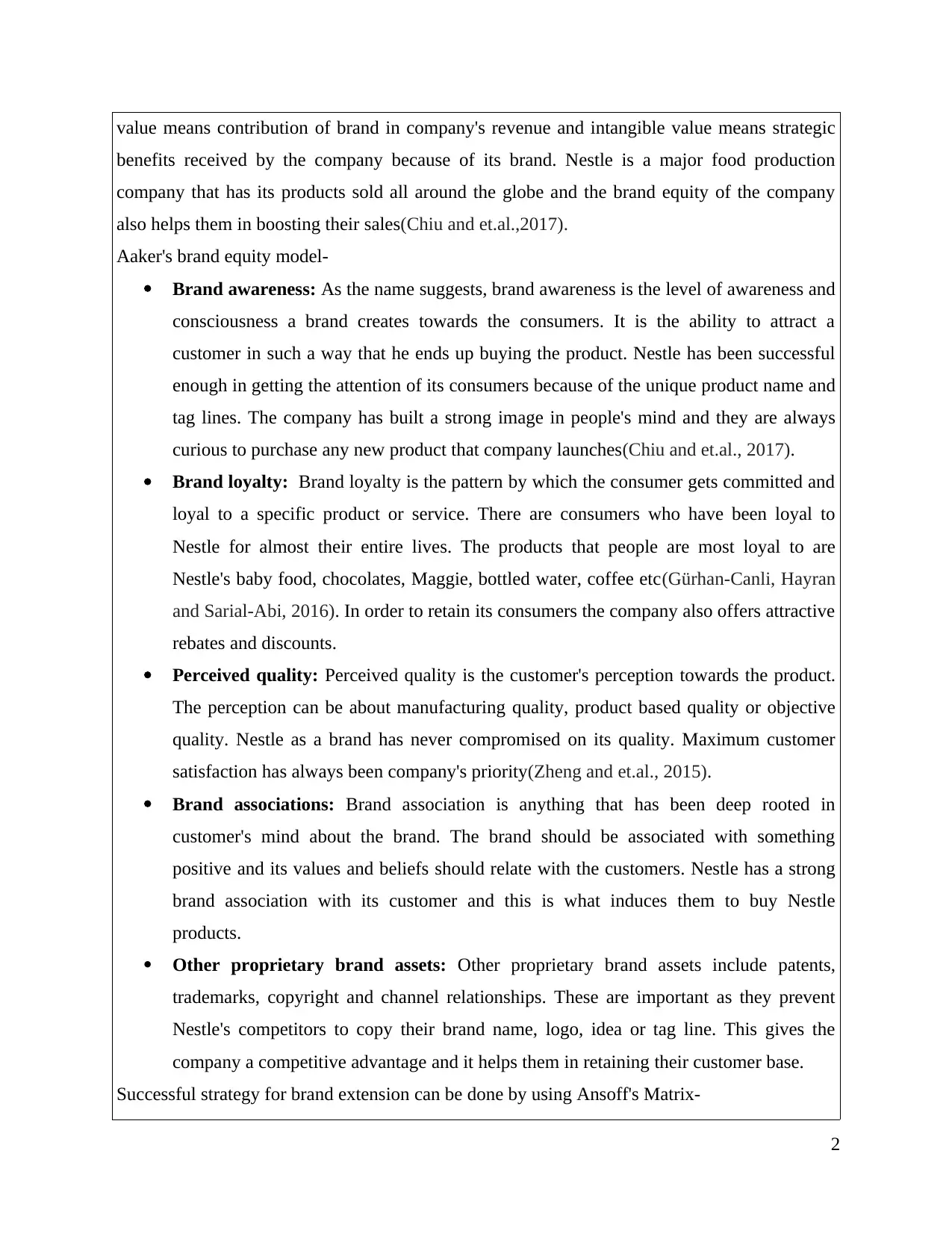
value means contribution of brand in company's revenue and intangible value means strategic
benefits received by the company because of its brand. Nestle is a major food production
company that has its products sold all around the globe and the brand equity of the company
also helps them in boosting their sales(Chiu and et.al.,2017).
Aaker's brand equity model-
Brand awareness: As the name suggests, brand awareness is the level of awareness and
consciousness a brand creates towards the consumers. It is the ability to attract a
customer in such a way that he ends up buying the product. Nestle has been successful
enough in getting the attention of its consumers because of the unique product name and
tag lines. The company has built a strong image in people's mind and they are always
curious to purchase any new product that company launches(Chiu and et.al., 2017).
Brand loyalty: Brand loyalty is the pattern by which the consumer gets committed and
loyal to a specific product or service. There are consumers who have been loyal to
Nestle for almost their entire lives. The products that people are most loyal to are
Nestle's baby food, chocolates, Maggie, bottled water, coffee etc(Gürhan-Canli, Hayran
and Sarial-Abi, 2016). In order to retain its consumers the company also offers attractive
rebates and discounts.
Perceived quality: Perceived quality is the customer's perception towards the product.
The perception can be about manufacturing quality, product based quality or objective
quality. Nestle as a brand has never compromised on its quality. Maximum customer
satisfaction has always been company's priority(Zheng and et.al., 2015).
Brand associations: Brand association is anything that has been deep rooted in
customer's mind about the brand. The brand should be associated with something
positive and its values and beliefs should relate with the customers. Nestle has a strong
brand association with its customer and this is what induces them to buy Nestle
products.
Other proprietary brand assets: Other proprietary brand assets include patents,
trademarks, copyright and channel relationships. These are important as they prevent
Nestle's competitors to copy their brand name, logo, idea or tag line. This gives the
company a competitive advantage and it helps them in retaining their customer base.
Successful strategy for brand extension can be done by using Ansoff's Matrix-
2
benefits received by the company because of its brand. Nestle is a major food production
company that has its products sold all around the globe and the brand equity of the company
also helps them in boosting their sales(Chiu and et.al.,2017).
Aaker's brand equity model-
Brand awareness: As the name suggests, brand awareness is the level of awareness and
consciousness a brand creates towards the consumers. It is the ability to attract a
customer in such a way that he ends up buying the product. Nestle has been successful
enough in getting the attention of its consumers because of the unique product name and
tag lines. The company has built a strong image in people's mind and they are always
curious to purchase any new product that company launches(Chiu and et.al., 2017).
Brand loyalty: Brand loyalty is the pattern by which the consumer gets committed and
loyal to a specific product or service. There are consumers who have been loyal to
Nestle for almost their entire lives. The products that people are most loyal to are
Nestle's baby food, chocolates, Maggie, bottled water, coffee etc(Gürhan-Canli, Hayran
and Sarial-Abi, 2016). In order to retain its consumers the company also offers attractive
rebates and discounts.
Perceived quality: Perceived quality is the customer's perception towards the product.
The perception can be about manufacturing quality, product based quality or objective
quality. Nestle as a brand has never compromised on its quality. Maximum customer
satisfaction has always been company's priority(Zheng and et.al., 2015).
Brand associations: Brand association is anything that has been deep rooted in
customer's mind about the brand. The brand should be associated with something
positive and its values and beliefs should relate with the customers. Nestle has a strong
brand association with its customer and this is what induces them to buy Nestle
products.
Other proprietary brand assets: Other proprietary brand assets include patents,
trademarks, copyright and channel relationships. These are important as they prevent
Nestle's competitors to copy their brand name, logo, idea or tag line. This gives the
company a competitive advantage and it helps them in retaining their customer base.
Successful strategy for brand extension can be done by using Ansoff's Matrix-
2
Paraphrase This Document
Need a fresh take? Get an instant paraphrase of this document with our AI Paraphraser
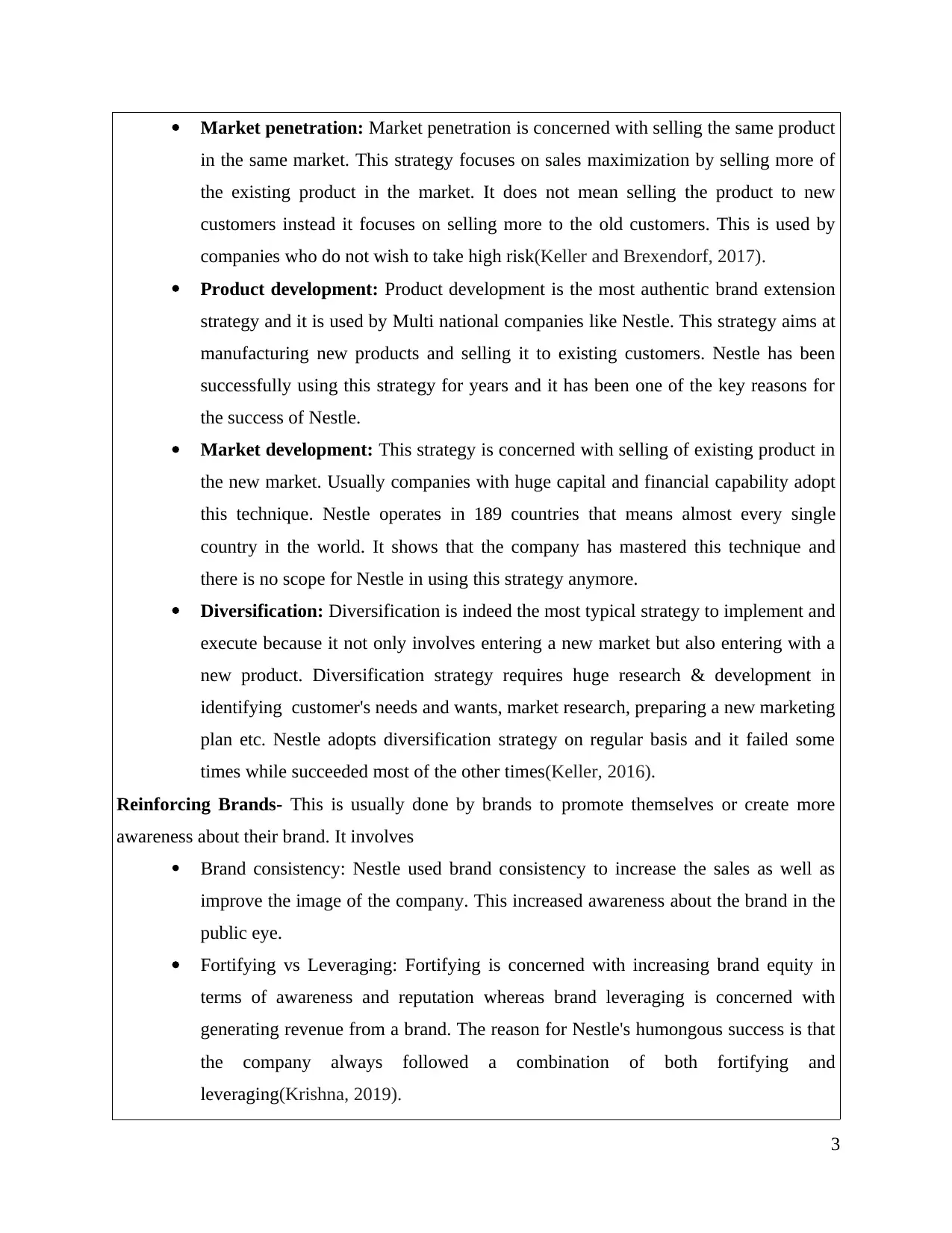
Market penetration: Market penetration is concerned with selling the same product
in the same market. This strategy focuses on sales maximization by selling more of
the existing product in the market. It does not mean selling the product to new
customers instead it focuses on selling more to the old customers. This is used by
companies who do not wish to take high risk(Keller and Brexendorf, 2017).
Product development: Product development is the most authentic brand extension
strategy and it is used by Multi national companies like Nestle. This strategy aims at
manufacturing new products and selling it to existing customers. Nestle has been
successfully using this strategy for years and it has been one of the key reasons for
the success of Nestle.
Market development: This strategy is concerned with selling of existing product in
the new market. Usually companies with huge capital and financial capability adopt
this technique. Nestle operates in 189 countries that means almost every single
country in the world. It shows that the company has mastered this technique and
there is no scope for Nestle in using this strategy anymore.
Diversification: Diversification is indeed the most typical strategy to implement and
execute because it not only involves entering a new market but also entering with a
new product. Diversification strategy requires huge research & development in
identifying customer's needs and wants, market research, preparing a new marketing
plan etc. Nestle adopts diversification strategy on regular basis and it failed some
times while succeeded most of the other times(Keller, 2016).
Reinforcing Brands- This is usually done by brands to promote themselves or create more
awareness about their brand. It involves
Brand consistency: Nestle used brand consistency to increase the sales as well as
improve the image of the company. This increased awareness about the brand in the
public eye.
Fortifying vs Leveraging: Fortifying is concerned with increasing brand equity in
terms of awareness and reputation whereas brand leveraging is concerned with
generating revenue from a brand. The reason for Nestle's humongous success is that
the company always followed a combination of both fortifying and
leveraging(Krishna, 2019).
3
in the same market. This strategy focuses on sales maximization by selling more of
the existing product in the market. It does not mean selling the product to new
customers instead it focuses on selling more to the old customers. This is used by
companies who do not wish to take high risk(Keller and Brexendorf, 2017).
Product development: Product development is the most authentic brand extension
strategy and it is used by Multi national companies like Nestle. This strategy aims at
manufacturing new products and selling it to existing customers. Nestle has been
successfully using this strategy for years and it has been one of the key reasons for
the success of Nestle.
Market development: This strategy is concerned with selling of existing product in
the new market. Usually companies with huge capital and financial capability adopt
this technique. Nestle operates in 189 countries that means almost every single
country in the world. It shows that the company has mastered this technique and
there is no scope for Nestle in using this strategy anymore.
Diversification: Diversification is indeed the most typical strategy to implement and
execute because it not only involves entering a new market but also entering with a
new product. Diversification strategy requires huge research & development in
identifying customer's needs and wants, market research, preparing a new marketing
plan etc. Nestle adopts diversification strategy on regular basis and it failed some
times while succeeded most of the other times(Keller, 2016).
Reinforcing Brands- This is usually done by brands to promote themselves or create more
awareness about their brand. It involves
Brand consistency: Nestle used brand consistency to increase the sales as well as
improve the image of the company. This increased awareness about the brand in the
public eye.
Fortifying vs Leveraging: Fortifying is concerned with increasing brand equity in
terms of awareness and reputation whereas brand leveraging is concerned with
generating revenue from a brand. The reason for Nestle's humongous success is that
the company always followed a combination of both fortifying and
leveraging(Krishna, 2019).
3
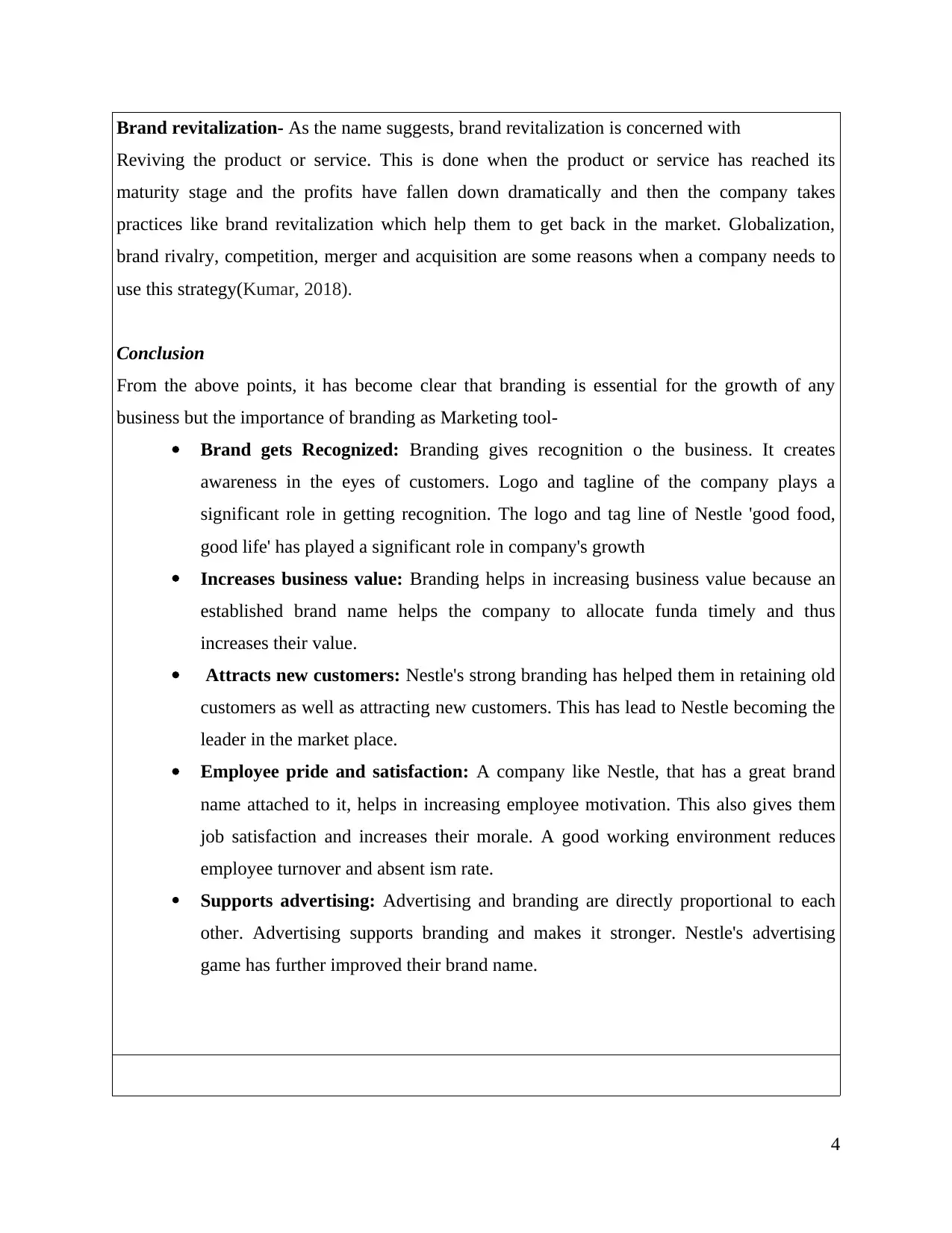
Brand revitalization- As the name suggests, brand revitalization is concerned with
Reviving the product or service. This is done when the product or service has reached its
maturity stage and the profits have fallen down dramatically and then the company takes
practices like brand revitalization which help them to get back in the market. Globalization,
brand rivalry, competition, merger and acquisition are some reasons when a company needs to
use this strategy(Kumar, 2018).
Conclusion
From the above points, it has become clear that branding is essential for the growth of any
business but the importance of branding as Marketing tool-
Brand gets Recognized: Branding gives recognition o the business. It creates
awareness in the eyes of customers. Logo and tagline of the company plays a
significant role in getting recognition. The logo and tag line of Nestle 'good food,
good life' has played a significant role in company's growth
Increases business value: Branding helps in increasing business value because an
established brand name helps the company to allocate funda timely and thus
increases their value.
Attracts new customers: Nestle's strong branding has helped them in retaining old
customers as well as attracting new customers. This has lead to Nestle becoming the
leader in the market place.
Employee pride and satisfaction: A company like Nestle, that has a great brand
name attached to it, helps in increasing employee motivation. This also gives them
job satisfaction and increases their morale. A good working environment reduces
employee turnover and absent ism rate.
Supports advertising: Advertising and branding are directly proportional to each
other. Advertising supports branding and makes it stronger. Nestle's advertising
game has further improved their brand name.
4
Reviving the product or service. This is done when the product or service has reached its
maturity stage and the profits have fallen down dramatically and then the company takes
practices like brand revitalization which help them to get back in the market. Globalization,
brand rivalry, competition, merger and acquisition are some reasons when a company needs to
use this strategy(Kumar, 2018).
Conclusion
From the above points, it has become clear that branding is essential for the growth of any
business but the importance of branding as Marketing tool-
Brand gets Recognized: Branding gives recognition o the business. It creates
awareness in the eyes of customers. Logo and tagline of the company plays a
significant role in getting recognition. The logo and tag line of Nestle 'good food,
good life' has played a significant role in company's growth
Increases business value: Branding helps in increasing business value because an
established brand name helps the company to allocate funda timely and thus
increases their value.
Attracts new customers: Nestle's strong branding has helped them in retaining old
customers as well as attracting new customers. This has lead to Nestle becoming the
leader in the market place.
Employee pride and satisfaction: A company like Nestle, that has a great brand
name attached to it, helps in increasing employee motivation. This also gives them
job satisfaction and increases their morale. A good working environment reduces
employee turnover and absent ism rate.
Supports advertising: Advertising and branding are directly proportional to each
other. Advertising supports branding and makes it stronger. Nestle's advertising
game has further improved their brand name.
4
⊘ This is a preview!⊘
Do you want full access?
Subscribe today to unlock all pages.

Trusted by 1+ million students worldwide
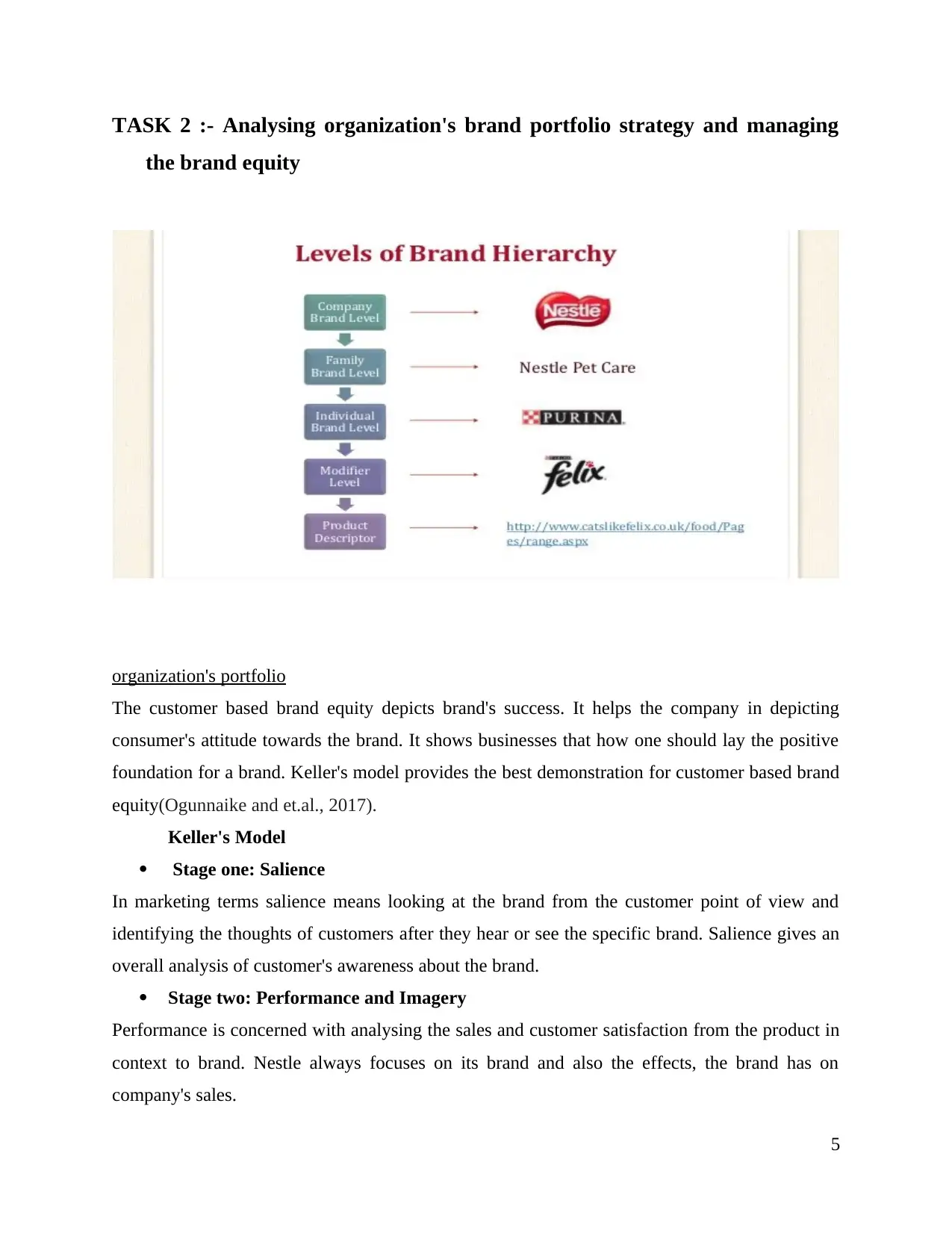
TASK 2 :- Analysing organization's brand portfolio strategy and managing
the brand equity
organization's portfolio
The customer based brand equity depicts brand's success. It helps the company in depicting
consumer's attitude towards the brand. It shows businesses that how one should lay the positive
foundation for a brand. Keller's model provides the best demonstration for customer based brand
equity(Ogunnaike and et.al., 2017).
Keller's Model
Stage one: Salience
In marketing terms salience means looking at the brand from the customer point of view and
identifying the thoughts of customers after they hear or see the specific brand. Salience gives an
overall analysis of customer's awareness about the brand.
Stage two: Performance and Imagery
Performance is concerned with analysing the sales and customer satisfaction from the product in
context to brand. Nestle always focuses on its brand and also the effects, the brand has on
company's sales.
5
the brand equity
organization's portfolio
The customer based brand equity depicts brand's success. It helps the company in depicting
consumer's attitude towards the brand. It shows businesses that how one should lay the positive
foundation for a brand. Keller's model provides the best demonstration for customer based brand
equity(Ogunnaike and et.al., 2017).
Keller's Model
Stage one: Salience
In marketing terms salience means looking at the brand from the customer point of view and
identifying the thoughts of customers after they hear or see the specific brand. Salience gives an
overall analysis of customer's awareness about the brand.
Stage two: Performance and Imagery
Performance is concerned with analysing the sales and customer satisfaction from the product in
context to brand. Nestle always focuses on its brand and also the effects, the brand has on
company's sales.
5
Paraphrase This Document
Need a fresh take? Get an instant paraphrase of this document with our AI Paraphraser
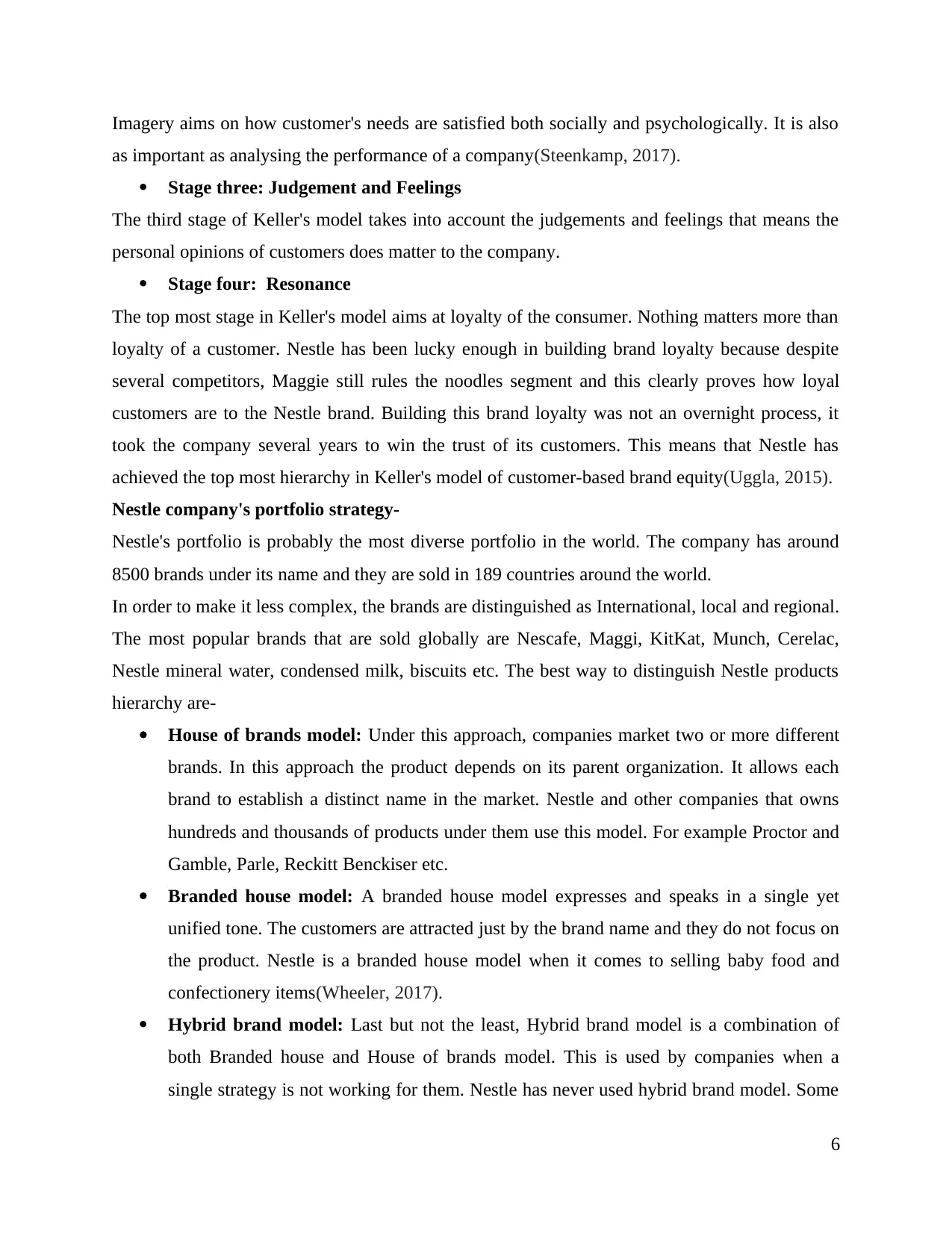
Imagery aims on how customer's needs are satisfied both socially and psychologically. It is also
as important as analysing the performance of a company(Steenkamp, 2017).
Stage three: Judgement and Feelings
The third stage of Keller's model takes into account the judgements and feelings that means the
personal opinions of customers does matter to the company.
Stage four: Resonance
The top most stage in Keller's model aims at loyalty of the consumer. Nothing matters more than
loyalty of a customer. Nestle has been lucky enough in building brand loyalty because despite
several competitors, Maggie still rules the noodles segment and this clearly proves how loyal
customers are to the Nestle brand. Building this brand loyalty was not an overnight process, it
took the company several years to win the trust of its customers. This means that Nestle has
achieved the top most hierarchy in Keller's model of customer-based brand equity(Uggla, 2015).
Nestle company's portfolio strategy-
Nestle's portfolio is probably the most diverse portfolio in the world. The company has around
8500 brands under its name and they are sold in 189 countries around the world.
In order to make it less complex, the brands are distinguished as International, local and regional.
The most popular brands that are sold globally are Nescafe, Maggi, KitKat, Munch, Cerelac,
Nestle mineral water, condensed milk, biscuits etc. The best way to distinguish Nestle products
hierarchy are-
House of brands model: Under this approach, companies market two or more different
brands. In this approach the product depends on its parent organization. It allows each
brand to establish a distinct name in the market. Nestle and other companies that owns
hundreds and thousands of products under them use this model. For example Proctor and
Gamble, Parle, Reckitt Benckiser etc.
Branded house model: A branded house model expresses and speaks in a single yet
unified tone. The customers are attracted just by the brand name and they do not focus on
the product. Nestle is a branded house model when it comes to selling baby food and
confectionery items(Wheeler, 2017).
Hybrid brand model: Last but not the least, Hybrid brand model is a combination of
both Branded house and House of brands model. This is used by companies when a
single strategy is not working for them. Nestle has never used hybrid brand model. Some
6
as important as analysing the performance of a company(Steenkamp, 2017).
Stage three: Judgement and Feelings
The third stage of Keller's model takes into account the judgements and feelings that means the
personal opinions of customers does matter to the company.
Stage four: Resonance
The top most stage in Keller's model aims at loyalty of the consumer. Nothing matters more than
loyalty of a customer. Nestle has been lucky enough in building brand loyalty because despite
several competitors, Maggie still rules the noodles segment and this clearly proves how loyal
customers are to the Nestle brand. Building this brand loyalty was not an overnight process, it
took the company several years to win the trust of its customers. This means that Nestle has
achieved the top most hierarchy in Keller's model of customer-based brand equity(Uggla, 2015).
Nestle company's portfolio strategy-
Nestle's portfolio is probably the most diverse portfolio in the world. The company has around
8500 brands under its name and they are sold in 189 countries around the world.
In order to make it less complex, the brands are distinguished as International, local and regional.
The most popular brands that are sold globally are Nescafe, Maggi, KitKat, Munch, Cerelac,
Nestle mineral water, condensed milk, biscuits etc. The best way to distinguish Nestle products
hierarchy are-
House of brands model: Under this approach, companies market two or more different
brands. In this approach the product depends on its parent organization. It allows each
brand to establish a distinct name in the market. Nestle and other companies that owns
hundreds and thousands of products under them use this model. For example Proctor and
Gamble, Parle, Reckitt Benckiser etc.
Branded house model: A branded house model expresses and speaks in a single yet
unified tone. The customers are attracted just by the brand name and they do not focus on
the product. Nestle is a branded house model when it comes to selling baby food and
confectionery items(Wheeler, 2017).
Hybrid brand model: Last but not the least, Hybrid brand model is a combination of
both Branded house and House of brands model. This is used by companies when a
single strategy is not working for them. Nestle has never used hybrid brand model. Some
6
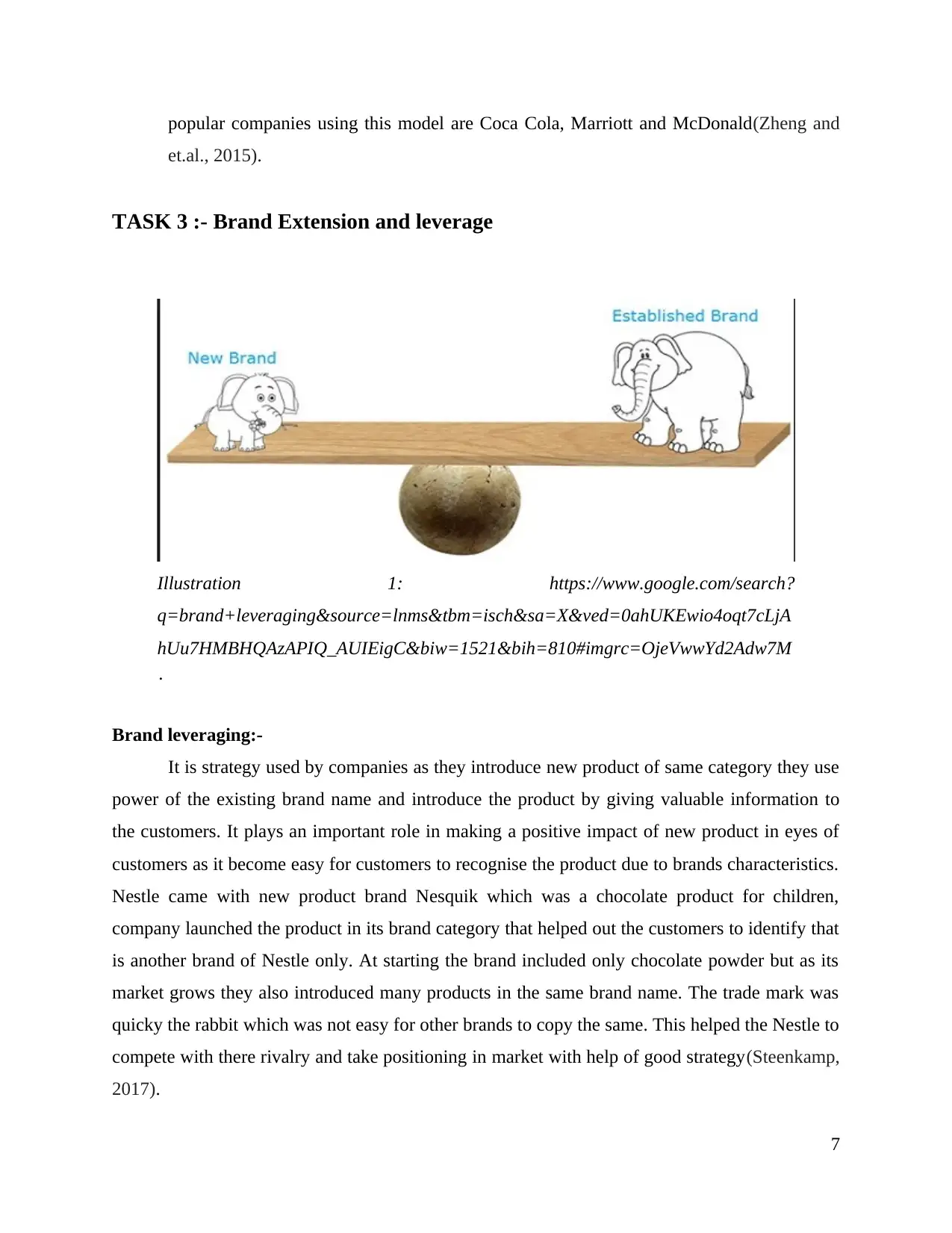
popular companies using this model are Coca Cola, Marriott and McDonald(Zheng and
et.al., 2015).
TASK 3 :- Brand Extension and leverage
Brand leveraging:-
It is strategy used by companies as they introduce new product of same category they use
power of the existing brand name and introduce the product by giving valuable information to
the customers. It plays an important role in making a positive impact of new product in eyes of
customers as it become easy for customers to recognise the product due to brands characteristics.
Nestle came with new product brand Nesquik which was a chocolate product for children,
company launched the product in its brand category that helped out the customers to identify that
is another brand of Nestle only. At starting the brand included only chocolate powder but as its
market grows they also introduced many products in the same brand name. The trade mark was
quicky the rabbit which was not easy for other brands to copy the same. This helped the Nestle to
compete with there rivalry and take positioning in market with help of good strategy(Steenkamp,
2017).
7
Illustration 1: https://www.google.com/search?
q=brand+leveraging&source=lnms&tbm=isch&sa=X&ved=0ahUKEwio4oqt7cLjA
hUu7HMBHQAzAPIQ_AUIEigC&biw=1521&bih=810#imgrc=OjeVwwYd2Adw7M
:
et.al., 2015).
TASK 3 :- Brand Extension and leverage
Brand leveraging:-
It is strategy used by companies as they introduce new product of same category they use
power of the existing brand name and introduce the product by giving valuable information to
the customers. It plays an important role in making a positive impact of new product in eyes of
customers as it become easy for customers to recognise the product due to brands characteristics.
Nestle came with new product brand Nesquik which was a chocolate product for children,
company launched the product in its brand category that helped out the customers to identify that
is another brand of Nestle only. At starting the brand included only chocolate powder but as its
market grows they also introduced many products in the same brand name. The trade mark was
quicky the rabbit which was not easy for other brands to copy the same. This helped the Nestle to
compete with there rivalry and take positioning in market with help of good strategy(Steenkamp,
2017).
7
Illustration 1: https://www.google.com/search?
q=brand+leveraging&source=lnms&tbm=isch&sa=X&ved=0ahUKEwio4oqt7cLjA
hUu7HMBHQAzAPIQ_AUIEigC&biw=1521&bih=810#imgrc=OjeVwwYd2Adw7M
:
⊘ This is a preview!⊘
Do you want full access?
Subscribe today to unlock all pages.

Trusted by 1+ million students worldwide
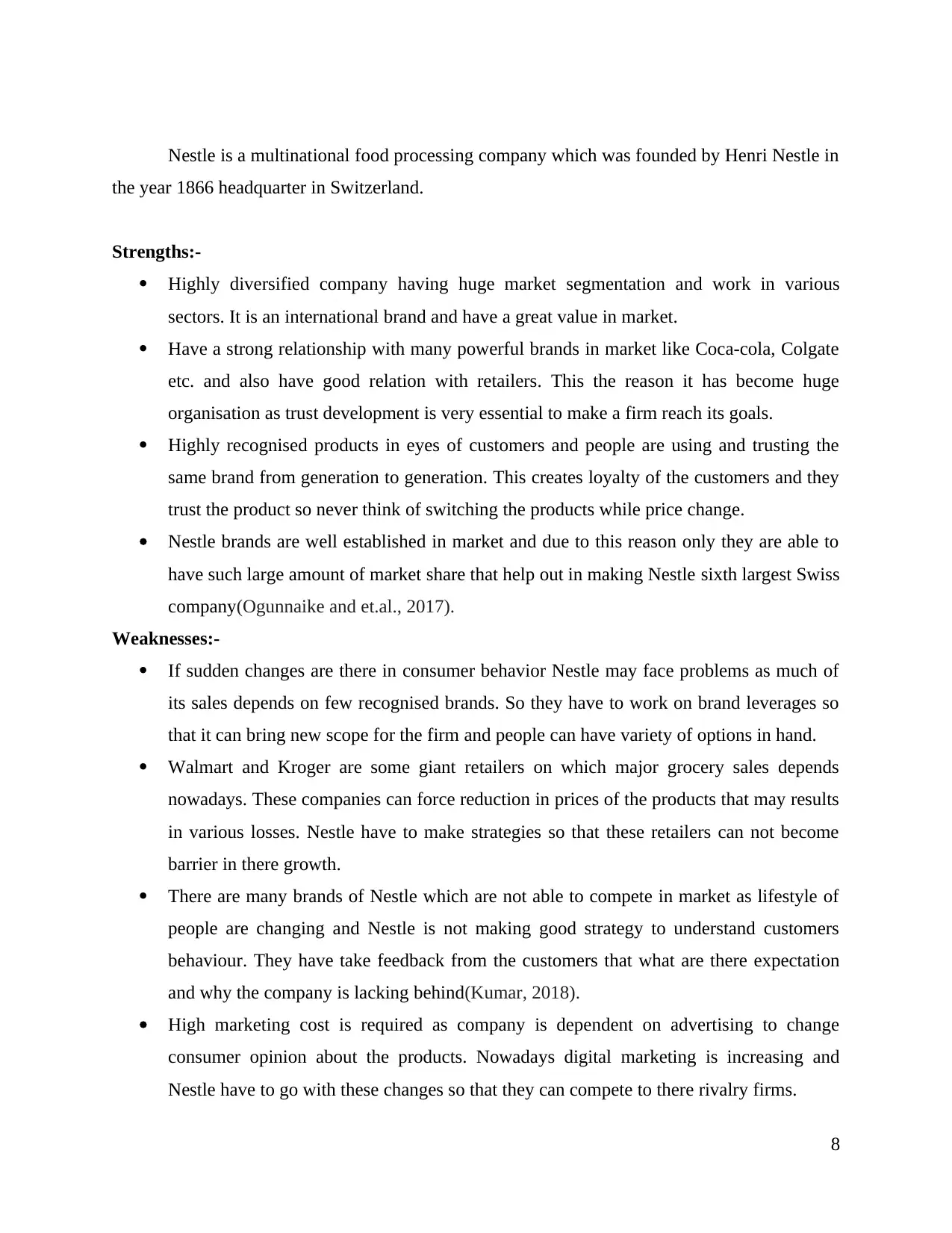
Nestle is a multinational food processing company which was founded by Henri Nestle in
the year 1866 headquarter in Switzerland.
Strengths:-
Highly diversified company having huge market segmentation and work in various
sectors. It is an international brand and have a great value in market.
Have a strong relationship with many powerful brands in market like Coca-cola, Colgate
etc. and also have good relation with retailers. This the reason it has become huge
organisation as trust development is very essential to make a firm reach its goals.
Highly recognised products in eyes of customers and people are using and trusting the
same brand from generation to generation. This creates loyalty of the customers and they
trust the product so never think of switching the products while price change.
Nestle brands are well established in market and due to this reason only they are able to
have such large amount of market share that help out in making Nestle sixth largest Swiss
company(Ogunnaike and et.al., 2017).
Weaknesses:-
If sudden changes are there in consumer behavior Nestle may face problems as much of
its sales depends on few recognised brands. So they have to work on brand leverages so
that it can bring new scope for the firm and people can have variety of options in hand.
Walmart and Kroger are some giant retailers on which major grocery sales depends
nowadays. These companies can force reduction in prices of the products that may results
in various losses. Nestle have to make strategies so that these retailers can not become
barrier in there growth.
There are many brands of Nestle which are not able to compete in market as lifestyle of
people are changing and Nestle is not making good strategy to understand customers
behaviour. They have take feedback from the customers that what are there expectation
and why the company is lacking behind(Kumar, 2018).
High marketing cost is required as company is dependent on advertising to change
consumer opinion about the products. Nowadays digital marketing is increasing and
Nestle have to go with these changes so that they can compete to there rivalry firms.
8
the year 1866 headquarter in Switzerland.
Strengths:-
Highly diversified company having huge market segmentation and work in various
sectors. It is an international brand and have a great value in market.
Have a strong relationship with many powerful brands in market like Coca-cola, Colgate
etc. and also have good relation with retailers. This the reason it has become huge
organisation as trust development is very essential to make a firm reach its goals.
Highly recognised products in eyes of customers and people are using and trusting the
same brand from generation to generation. This creates loyalty of the customers and they
trust the product so never think of switching the products while price change.
Nestle brands are well established in market and due to this reason only they are able to
have such large amount of market share that help out in making Nestle sixth largest Swiss
company(Ogunnaike and et.al., 2017).
Weaknesses:-
If sudden changes are there in consumer behavior Nestle may face problems as much of
its sales depends on few recognised brands. So they have to work on brand leverages so
that it can bring new scope for the firm and people can have variety of options in hand.
Walmart and Kroger are some giant retailers on which major grocery sales depends
nowadays. These companies can force reduction in prices of the products that may results
in various losses. Nestle have to make strategies so that these retailers can not become
barrier in there growth.
There are many brands of Nestle which are not able to compete in market as lifestyle of
people are changing and Nestle is not making good strategy to understand customers
behaviour. They have take feedback from the customers that what are there expectation
and why the company is lacking behind(Kumar, 2018).
High marketing cost is required as company is dependent on advertising to change
consumer opinion about the products. Nowadays digital marketing is increasing and
Nestle have to go with these changes so that they can compete to there rivalry firms.
8
Paraphrase This Document
Need a fresh take? Get an instant paraphrase of this document with our AI Paraphraser
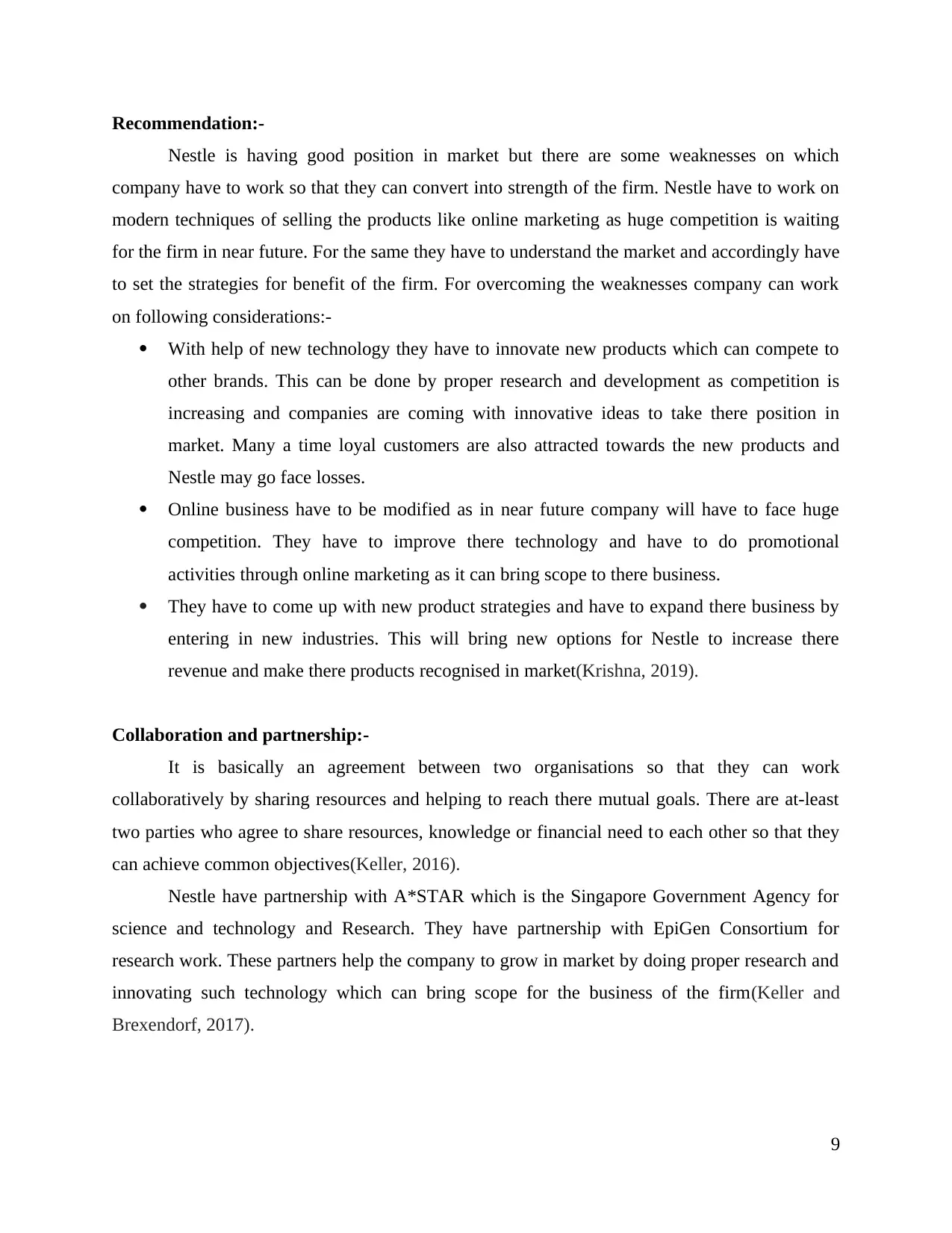
Recommendation:-
Nestle is having good position in market but there are some weaknesses on which
company have to work so that they can convert into strength of the firm. Nestle have to work on
modern techniques of selling the products like online marketing as huge competition is waiting
for the firm in near future. For the same they have to understand the market and accordingly have
to set the strategies for benefit of the firm. For overcoming the weaknesses company can work
on following considerations:-
With help of new technology they have to innovate new products which can compete to
other brands. This can be done by proper research and development as competition is
increasing and companies are coming with innovative ideas to take there position in
market. Many a time loyal customers are also attracted towards the new products and
Nestle may go face losses.
Online business have to be modified as in near future company will have to face huge
competition. They have to improve there technology and have to do promotional
activities through online marketing as it can bring scope to there business.
They have to come up with new product strategies and have to expand there business by
entering in new industries. This will bring new options for Nestle to increase there
revenue and make there products recognised in market(Krishna, 2019).
Collaboration and partnership:-
It is basically an agreement between two organisations so that they can work
collaboratively by sharing resources and helping to reach there mutual goals. There are at-least
two parties who agree to share resources, knowledge or financial need to each other so that they
can achieve common objectives(Keller, 2016).
Nestle have partnership with A*STAR which is the Singapore Government Agency for
science and technology and Research. They have partnership with EpiGen Consortium for
research work. These partners help the company to grow in market by doing proper research and
innovating such technology which can bring scope for the business of the firm(Keller and
Brexendorf, 2017).
9
Nestle is having good position in market but there are some weaknesses on which
company have to work so that they can convert into strength of the firm. Nestle have to work on
modern techniques of selling the products like online marketing as huge competition is waiting
for the firm in near future. For the same they have to understand the market and accordingly have
to set the strategies for benefit of the firm. For overcoming the weaknesses company can work
on following considerations:-
With help of new technology they have to innovate new products which can compete to
other brands. This can be done by proper research and development as competition is
increasing and companies are coming with innovative ideas to take there position in
market. Many a time loyal customers are also attracted towards the new products and
Nestle may go face losses.
Online business have to be modified as in near future company will have to face huge
competition. They have to improve there technology and have to do promotional
activities through online marketing as it can bring scope to there business.
They have to come up with new product strategies and have to expand there business by
entering in new industries. This will bring new options for Nestle to increase there
revenue and make there products recognised in market(Krishna, 2019).
Collaboration and partnership:-
It is basically an agreement between two organisations so that they can work
collaboratively by sharing resources and helping to reach there mutual goals. There are at-least
two parties who agree to share resources, knowledge or financial need to each other so that they
can achieve common objectives(Keller, 2016).
Nestle have partnership with A*STAR which is the Singapore Government Agency for
science and technology and Research. They have partnership with EpiGen Consortium for
research work. These partners help the company to grow in market by doing proper research and
innovating such technology which can bring scope for the business of the firm(Keller and
Brexendorf, 2017).
9
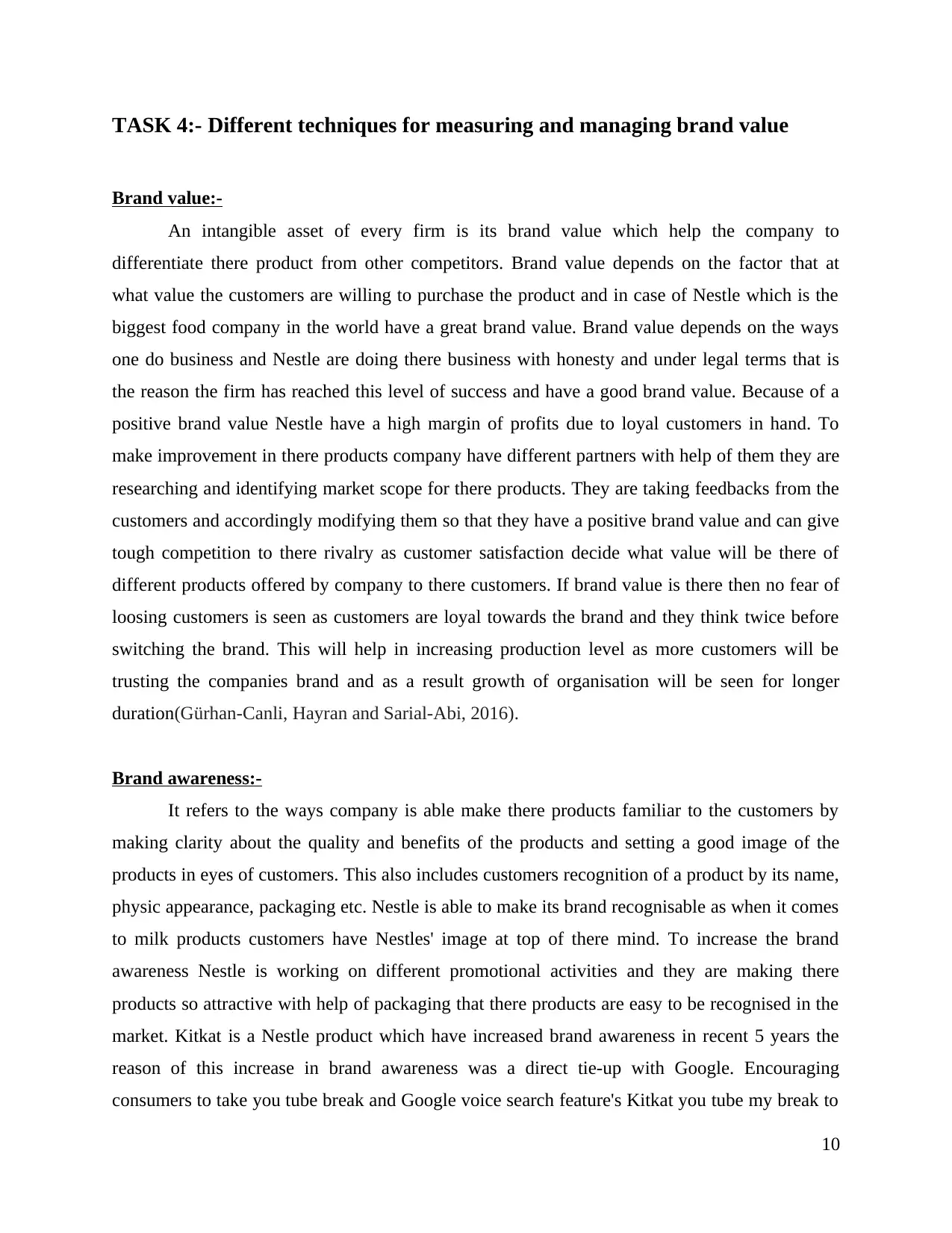
TASK 4:- Different techniques for measuring and managing brand value
Brand value:-
An intangible asset of every firm is its brand value which help the company to
differentiate there product from other competitors. Brand value depends on the factor that at
what value the customers are willing to purchase the product and in case of Nestle which is the
biggest food company in the world have a great brand value. Brand value depends on the ways
one do business and Nestle are doing there business with honesty and under legal terms that is
the reason the firm has reached this level of success and have a good brand value. Because of a
positive brand value Nestle have a high margin of profits due to loyal customers in hand. To
make improvement in there products company have different partners with help of them they are
researching and identifying market scope for there products. They are taking feedbacks from the
customers and accordingly modifying them so that they have a positive brand value and can give
tough competition to there rivalry as customer satisfaction decide what value will be there of
different products offered by company to there customers. If brand value is there then no fear of
loosing customers is seen as customers are loyal towards the brand and they think twice before
switching the brand. This will help in increasing production level as more customers will be
trusting the companies brand and as a result growth of organisation will be seen for longer
duration(Gürhan-Canli, Hayran and Sarial-Abi, 2016).
Brand awareness:-
It refers to the ways company is able make there products familiar to the customers by
making clarity about the quality and benefits of the products and setting a good image of the
products in eyes of customers. This also includes customers recognition of a product by its name,
physic appearance, packaging etc. Nestle is able to make its brand recognisable as when it comes
to milk products customers have Nestles' image at top of there mind. To increase the brand
awareness Nestle is working on different promotional activities and they are making there
products so attractive with help of packaging that there products are easy to be recognised in the
market. Kitkat is a Nestle product which have increased brand awareness in recent 5 years the
reason of this increase in brand awareness was a direct tie-up with Google. Encouraging
consumers to take you tube break and Google voice search feature's Kitkat you tube my break to
10
Brand value:-
An intangible asset of every firm is its brand value which help the company to
differentiate there product from other competitors. Brand value depends on the factor that at
what value the customers are willing to purchase the product and in case of Nestle which is the
biggest food company in the world have a great brand value. Brand value depends on the ways
one do business and Nestle are doing there business with honesty and under legal terms that is
the reason the firm has reached this level of success and have a good brand value. Because of a
positive brand value Nestle have a high margin of profits due to loyal customers in hand. To
make improvement in there products company have different partners with help of them they are
researching and identifying market scope for there products. They are taking feedbacks from the
customers and accordingly modifying them so that they have a positive brand value and can give
tough competition to there rivalry as customer satisfaction decide what value will be there of
different products offered by company to there customers. If brand value is there then no fear of
loosing customers is seen as customers are loyal towards the brand and they think twice before
switching the brand. This will help in increasing production level as more customers will be
trusting the companies brand and as a result growth of organisation will be seen for longer
duration(Gürhan-Canli, Hayran and Sarial-Abi, 2016).
Brand awareness:-
It refers to the ways company is able make there products familiar to the customers by
making clarity about the quality and benefits of the products and setting a good image of the
products in eyes of customers. This also includes customers recognition of a product by its name,
physic appearance, packaging etc. Nestle is able to make its brand recognisable as when it comes
to milk products customers have Nestles' image at top of there mind. To increase the brand
awareness Nestle is working on different promotional activities and they are making there
products so attractive with help of packaging that there products are easy to be recognised in the
market. Kitkat is a Nestle product which have increased brand awareness in recent 5 years the
reason of this increase in brand awareness was a direct tie-up with Google. Encouraging
consumers to take you tube break and Google voice search feature's Kitkat you tube my break to
10
⊘ This is a preview!⊘
Do you want full access?
Subscribe today to unlock all pages.

Trusted by 1+ million students worldwide
1 out of 15
Related Documents
Your All-in-One AI-Powered Toolkit for Academic Success.
+13062052269
info@desklib.com
Available 24*7 on WhatsApp / Email
![[object Object]](/_next/static/media/star-bottom.7253800d.svg)
Unlock your academic potential
Copyright © 2020–2025 A2Z Services. All Rights Reserved. Developed and managed by ZUCOL.




